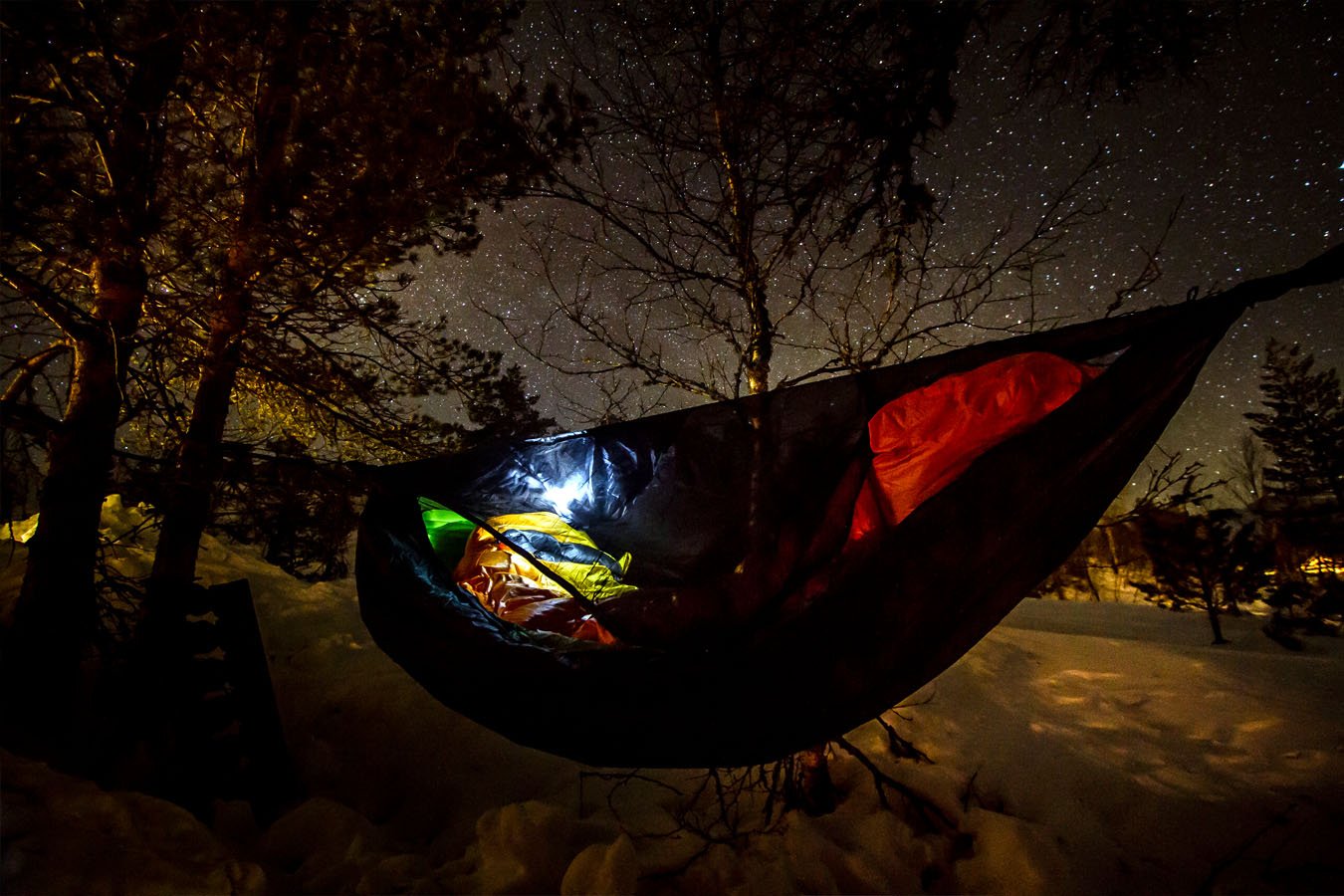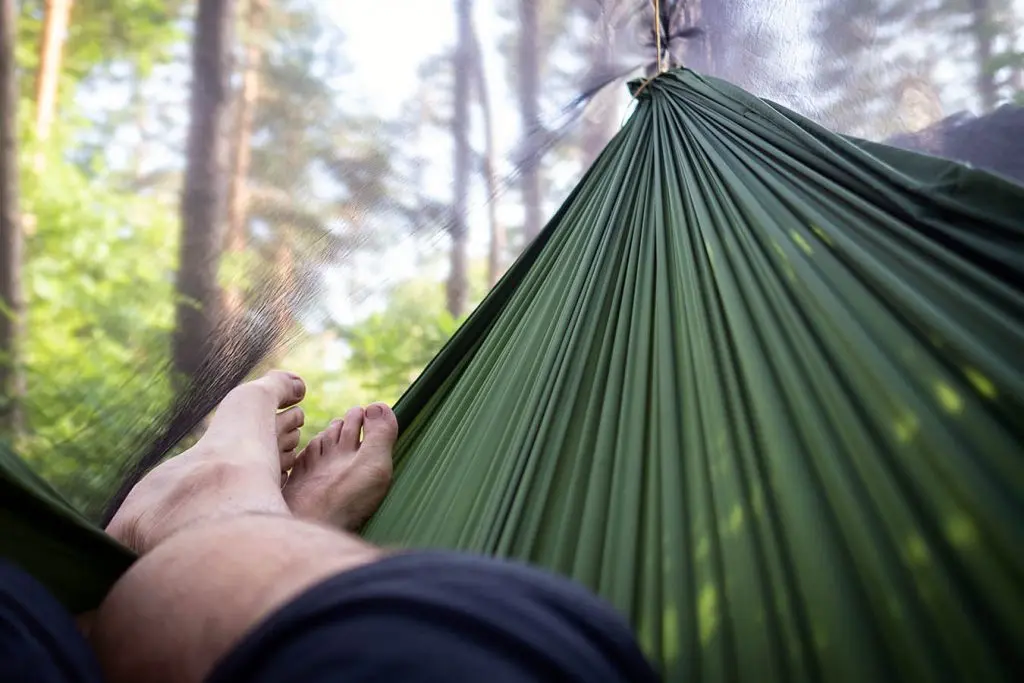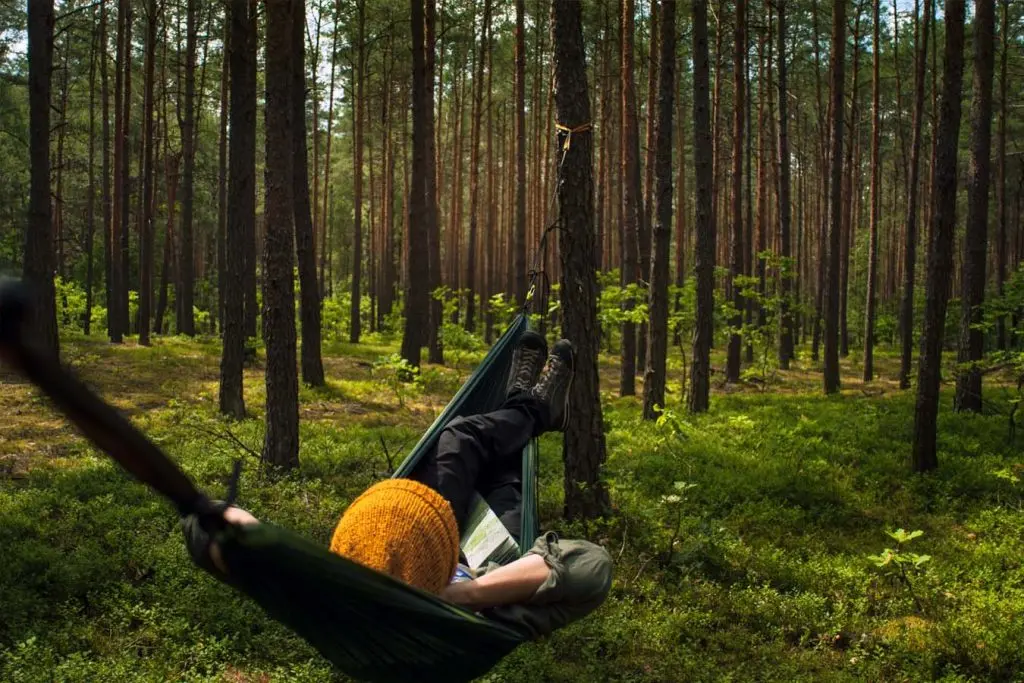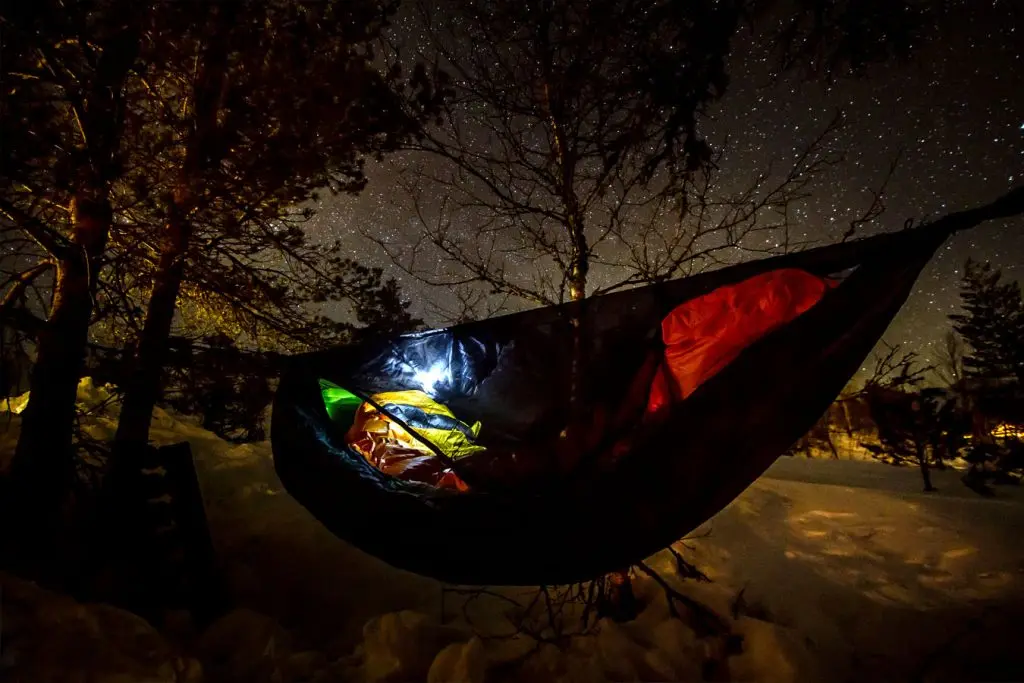Sleeping in a hammock is fun but it can also be very comfortable based on solid principles. From targeting hammock sag to sleeping diagonally, there are a few good tips to consider for nighttime comfort. The following guidelines apply for comfortable sleeping in all types of hammocks.
Top tips on how to sleep in a hammock
Hammocks are quick to set up and they offer an alternative to sleeping in tents, and believe it or not, when set up correctly they can even offer a very comfortable method of outdoor sleeping. Lounging in a hammock can be both safe and comfortable when following these guidelines.
Hang the hammock correctly
A good nights’ sleep begins with hanging your hammock correctly. It shouldn’t be too tight. A hammock should have good sag or a good curve which is where most users find comfort. Unlike a bed, it isn’t made for sleeping straight.
Always sleep diagonally
Hammocks are not made for sleeping in a straight position. Sleeping diagonally ensures better support in a flat position and it also opens up the hammock considerably. Lying across the fabrics allows the head and the feet to drop down in a straight sleeping position.
Buy a sleeping pad
Since being off the ground exposes the camper to draft and low temperatures during the night, using a sleeping pad is wise. Sleeping pads trap air, creating an insulation layer between the user and the cold hammock.
Most campers recommend placing the sleeping pad in the sleeping bag to keep it from moving around too much during the night. Others recommend using an underquilt instead of a sleeping pad. But both a sleeping pad and an underquilt are made for proper thermal protection.
Always hang a drip line
Camping doesn’t stop during rainy days. Most campers who do a good job planning out camping gear essentials pack a hammock tarp. But a drip line is also essential.
Seen as a break in the anchoring line, normally placed under the tarp, the drip line prevents water from seeping down the suspension line.
Consider a knee pillow
Leg hyperextension is a problem for tall campers. Even when sleeping diagonally, the knees can over-extend, leading to pressure and even knee pain in the morning. This issue can be dealt with simply by placing a knee pillow under the knees. In the absence of a pillow, any piece of clothing should also work.
Wrap up or buy a mosquito net
Wrapping up in the hammock protects the skin and it also keeps mosquitoes away. However, mosquitoes might still sting through the thin hammock nylon. As a result, investing in a durable mosquito net is a must for those planning to comfortably sleep out in nature.
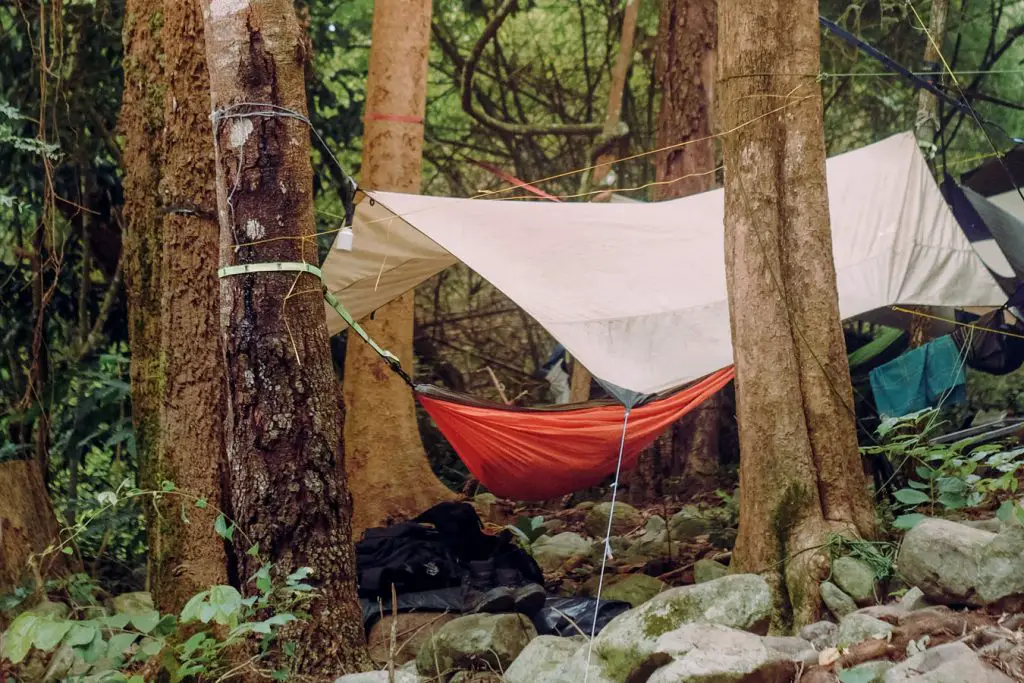
Pros of sleeping in a hammock
Did you know that you can fall asleep faster in a hammock? It’s one of its multiple benefits, and shows how sleeping in a hammock while camping is not the worst as it may offer a few things sleeping in a bed at home can’t.
Fall asleep faster – Research attributes falling asleep faster in a hammock to already being in a favoring position for deep sleep. Some research shows this could also be attributed to swaying. Regardless of these 2 cases, it’s clear hammocks favor falling asleep faster.
Those who want to enjoy a quick nap are also favored by the benefit. Without endless tossing and turning, hammocks offer the right platform for falling asleep fast. It may also help those camping as there’s no wasted nighttime sleep as most wake up early in the morning.
Sleep in the correct position – According to doctors, the head should always be 10-30% higher than the body for a correct sleeping position.
Hammocks offer this support as the head sits in a permanent position for the entire night. In this position, most rest properly, but it also prevents them from moving around too much.
Inside a hammock, it proves difficult to sleep on the stomach or even roll around. This correct sleeping position is maintained for the entire night.
Deep sleeping – Those who want to sleep in certainly find a hammock appealing. Deep sleep is enhanced by hammocks and there are many benefits associated with it. Deep sleeping is associated with better mood and improved mental performance.
Fight insomnia – Insomnia is a real issue but a simple hammock can help to fall asleep better constantly. Research shows there are many causes of insomnia. Some of them can be alleviated by transitioning to a hammock.
Apart from helping users deal with issues of falling asleep, a hammock also helps users sleep longer, which benefits the potential drawbacks lack of sleep comes with.
Improve comfort – A hammock feels different to a mattress as it comes with constant pressure on the body. A mattress is known for its pressure points. Since hammocks are suspended in the air, they don’t come with these and they enhance comfort with no pressure points.
Create a place to read – Reading in a hammock is comfortable with its elevated head position. But reading outdoors also benefits from perfect visibility with plenty of natural light.
Without requiring pillows, hammocks offer the right reading support with handy pocket storage for additional books.
Stay sharp with swaying – Swaying has been shown to offer multiple benefits. It helps babies fall asleep faster and it also helps adults with insomnia.
But swaying might also be beneficial simply to help the brain relax, even without sleeping. One of the main objectives of spending time outdoors is to help the brain relax.
It offers versatility – While tents need dry flat ground for camping, hammocks are more versatile. Pitched above the ground, they offer unmatched versatility since they can be used for camping almost in any location with trees.
It saves weight – Carrying heavy camping gear for long periods of time is very difficult, if not can seem impossible. While tents are considerably heavier, hammocks pack down to a small size and are also lighter.
Attached to the backpack, they can be helpful to hikers tired of having to deal with increasing camping gear weight. Even a rainfly, a bug net, and its suspension system are made to be lightweight.
Cons of sleeping in a hammock
Apart from a long list of benefits, hammocks also have their drawbacks. These drawbacks need to be taken into consideration, especially when new to the camping world.
There’s a learning curve – As with a tent, pitching a hammock takes some time to master. Ideally, campers should set up a hammock at home before heading out in the wilderness to see what the process requires.
Finding appropriate trees, dealing with the anchoring straps, or even setting up a mosquito net can take some time to master.
Staying warm requires extra tools – Staying warm inside a hammock is similar to staying warm in a tent. However, it might require different tools.
For example, quilts are used together with sleeping bags to stay warm, and a sleeping pad might also be needed during very cold nights.
With a cool draft of air underneath the hammock, there’s a need for added thermal protection even during the summer nights. Avoiding a cold back should be one of the main priorities of those who like sleeping in a hammock.
Confined to trees – Almost all camping and trekking locations have some level of trees. However, without trees, hammocks become impossible to use.
Campers need 2 solid trees to hang their hammock off and in some locations such as deserts or tree-less mountains, this is impossible to achieve.
Before heading out into the wilderness, campers should research the area’s forests and their camping locations.
Challenging to get out of – It isn’t easy to get into or out of the hammock. Even when going to sleep, users still need to prepare their sleeping bag, sleeping pad, and even a pillow. All of these need to be ready while maintaining balance when getting in.
Fear of falling out – Those new to hammock camping know that one of the biggest fears is falling out of the hammock. If it’s properly anchored, falling out is rarely a risk, however, their fear is still there as sleeping above ground level has a novelty element many tent sleepers are not familiar with.
Not ideal for couples – It’s rare to see a couple sleeping together in a hammock. While there are 2-person hammocks with the extra weight support, this doesn’t mean a couple feels comfortable in one. It takes consistent effort and synchronization to get the moves right in such a scenario.
Some parks prohibit hammocks – Some national parks do not allow hammocks. The biggest strength of the hammock which is its location independence becomes its biggest drawback. In this case, a camping stand might be an alternative, especially when camping next to your car.
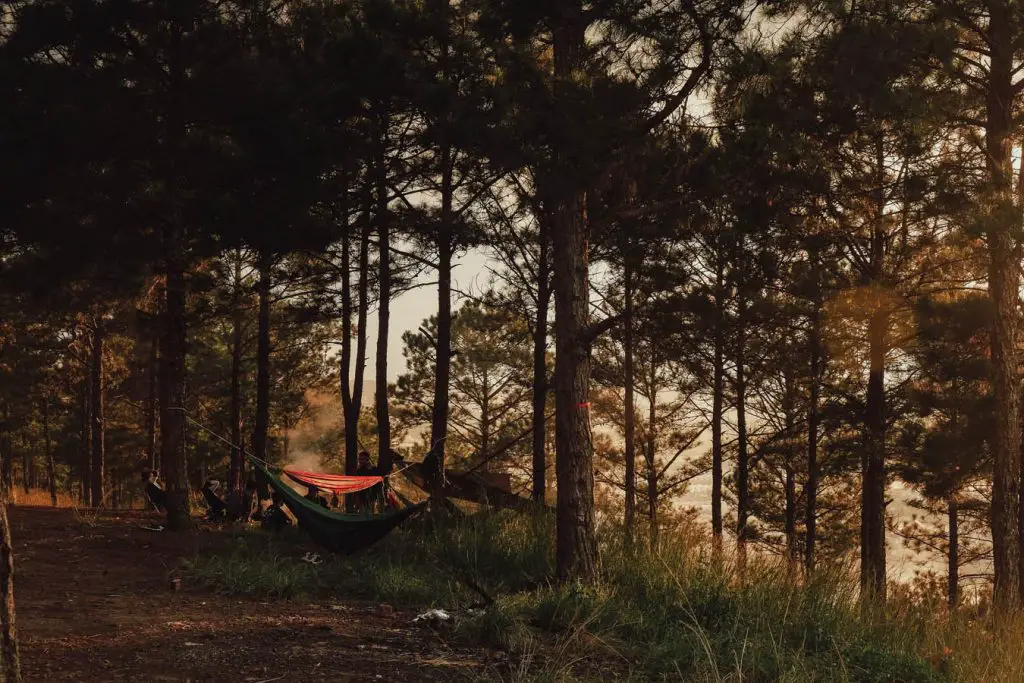
Sleeping in a hammock with a partner
Sleeping in a hammock with a partner is romantic. There are not as many 2-person hammocks as single person hammocks, however. Space limitations and fighting over top quilts make them less than ideal for couples out in nature.
Their pluses and minuses can be categorized as follows…
Pros of sleeping in a hammock with a partner
Extra warmth – The main benefit to a couple’s hammock is the extra warmth from body heat during the night. It’s here that many find the main benefit of these types of hammocks in the colder nights over the year.
Low camping gear weight – A hammock for couples only requires 2 straps and 2 carabiners instead of 4 straps and 4 carabiners with 2 hammocks. This can save weight, which is crucial when hiking.
It’s romantic – The romantic side of hammocks for couples is the main driver for its appeal. Most couples like to spend time together out in nature and these hammocks might be the next best solution after a 2-person tent.
Cons of sleeping in a hammock with a partner
It’s too warm – The extra heat from your partner might also be a drawback during the warmest nights of the year. Sweating during the night might not be the best when up in the air with drafts underneath the hammock.
Personal space – Every sleeper needs personal space. But the long sage of the 2-person hammock limits personal space, if it doesn’t make it inexistent. There’s no way of keeping the distance between the 2 sleepers in such a hammock.
Do you need a pillow in a hammock?
In theory, there’s no need for a pillow in a hammock. As long as the head sits at least 10 degrees above the body, campers should feel comfortable. As a matter of personal preference, some only prefer sleeping with a pillow, even inside a hammock.
No pillow – Sleeping without a pillow is possible in a hammock. Many sleeping bags have a surface to rest your head on, and this also offers thermal insulation needed against the cool air of the night.
Hammock pillows – Hammock pillows are made to be comfortable and even ergonomic. Available at low prices, these pillows push the hammock away from the face, allowing a bit more room to be created inside the hammock.
Camping pillows – Self-inflating and blow-up camping pillows can also be used for elevated sleeping positions. Under the head or under the knees, they can be useful for added comfort.
The self-inflating pillows are filled with foam or down and can even feature a valve. Blow-up pillows are compact when not inflated, and they can be considered for their space-saving benefits.
Travel pillows – Classic U-shape travel pillows are a good alternative to the options listed above. Sleeping in a hammock doesn’t require the use of a specialized pillow. Frequent travelers might convert their travel pillow to a camping pillow when out sleeping in nature.
What’s the right hammock angle?
There’s not too much to consider when it comes to a hammocks angle, however it is the right amount of sag that campers should be predominantly concentrating on.
The biggest error new campers make is hanging their hammock too tight, which causes its walls to be too high and rigid, and confining the sleeper to the center point.
With a hammock that is too tight, users also put a lot of pressure on the trees it is hung from.
Can you sleep in a hammock every night?
As research shows, sleeping in a hammock is beneficial to health. Campers even argue hammock sleeping makes them feel more energized when waking up in the morning.
Improved circulation is one of the benefits of sleeping in a hammock, as the elevated head position allows better blood flow.
Falling asleep faster is another benefit. Instead of struggling, swaying allows users to fall asleep faster and also enjoy a deeper nights rest.
It can also lead to campers feeling energized early in the morning. Instead of feeling their body heavy and barely dragging themselves out of the bed, hikers or trekkers feel revitalized when the sun’s up.
Can you sleep on your side in a hammock?
Sleeping on your back and sleeping on the side are notions with a different meaning in a hammock. Most of those who try to sleep on the side have mixed experiences and there’s a good chance it will also keep being a subjective matter for all campers.
Those who transition from sleeping on their side to sleeping on their back can usually maintain this sleeping position only inside a hammock and not when back in the comfortable bed at home.
Campers who like to sleep in the fetal position normally confine to the lower portions of the hammock. Stretching out would also stretch the hammock out meaning their sleeping position is also affected.
When there’s no other way to find comfort sleeping on the back or in the fetal position, side sleepers can also consider inflating their sleeping pad to a maximum degree.
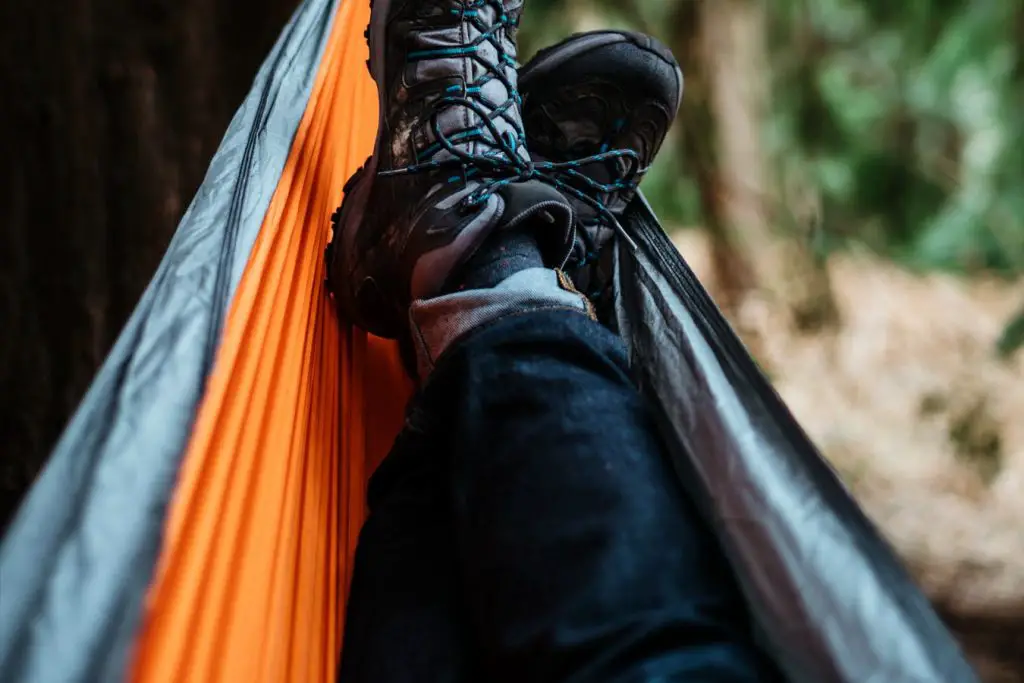
Why can’t you sleep in a hammock?
A few campers have a difficult time falling asleep in a hammock. This might be caused by the novelty of this method of sleeping, the hammock, of the way the hammock is set up. For most of these campers, it can be frustrating not to be able to fall asleep after miles of hiking.
A few tips can be applied to fall deeply asleep when transitioning to hammocks. Here’s what seasoned campers recommend…
Raise the feet end – Raising your feet about 6 inches higher than your head is one of the simple tricks that worked for a few campers. There might be room for a few experiments here as every user is different. But most agree their feet are too high whenever they fail to fall asleep.
Use a different hammock pillow – Coming from comfortable sleeping on a bed with a pillow, a hammock can feel quick claustrophobic. Experienced campers recommend trying out a different pillow with is similar elevation and level of cushioning to your one at home.
Learn from group camping – Setting up the hammock is standardized, but everyone has personal preferences. Campers who’ve once struggled to fall asleep recommend group outings for beginners.
It is here that those new to the camping world can find their own comfort setup simply by observing and learning from others.
As an alternative, users can also consider packing a tent for the first trip out in nature. However, most campers note it’s a matter of practice until fully accustomed to sleeping in a hammock.
Summary
Sleeping in a hammock is not complicated. With the right adjustments, even those new to this style of lightweight camping can enjoy deep sleeping.
Most importantly, hammock sleeping has a range of benefits that are hard to match via a tent or sleeping on the ground. From swaying which helps us to fall asleep faster, to traveling lightweight, there are plenty of reasons to consider hammocks as the first option for sleeping when out in nature.
Related guides
Hammock Camping Under Quilts vs Sleeping Pads
Hammock Camping During a Thunderstorm

